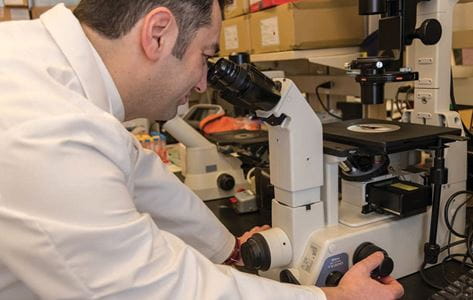Organs perform many functions essential to human life, but if they stop working, there aren’t many easy options to fix them.
According to the latest data from the Organ Procurement and Transplantation Network, there are more than 110,000 people in the United States waiting for a life-saving organ transplant. Each day, about 20 people die because a donor isn’t available.
But instead of waiting for a limited supply of organ donations from other humans, what if we could make the organs that we needed?
Indiana University School of Medicine scientists are closer than ever before, thanks to IU’s cutting- edge 3D bioprinting technology and a new, multi-million-dollar research agreement with an innovative industry partner.
IU School of Medicine faculty (left to right) Lester Smith, PhD; Burcin Ekser, MD, PhD; and Ping Li, PhD.
Led by Burcin Ekser, MD, PhD, assistant professor of surgery at IU School of Medicine, the team of researchers is working to print 3D tissue from genetically engineered pig cells. Then, they use this 3D-printed tissue to develop new research models for xenotransplantation, or cross-species transplantation.
The ultimate goal is to determine precisely which genetic alterations would be needed so that pig organs could safely and effectively be used in humans. And the biopharmaceutical industry is taking notice.
A powerful partnership
Ekser, who is director of the school’s xenotransplantation research lab, recently secured a four-year, $9 million sponsored research agreement from Lung
Biotechnology PBC, a wholly owned subsidiary of United Therapeutics Corporation. Lung Biotechnology is a Maryland-based company focused on organ transplantation technologies, including xenotransplantation.
“This alliance with Lung Biotechnology will greatly enhance our ability to accomplish our ultimate goal of providing an unlimited supply of organs to save human lives,” Ekser said. “It’s my passion because I’m a transplant surgeon; I don’t want anyone to die while they’re waiting for a transplantable organ.”
The idea of using animal tissue for medical purposes in humans is not new. For instance, heart valve replacements are commonly made from pig or cow tissue.
When it comes to transplantable organs, pigs just might make the ideal donor. For starters, their organs are the right size. They can easily be raised in sterile environments, reducing the likelihood of infection. And since we are accustomed to breeding pigs for food, breeding them to save lives doesn’t create an ethical dilemma for many people.
But there are still significant challenges that must be overcome, the most notable of which is that the human body recognizes the pig organ as foreign and rejects it. To address that problem, xenotransplantation researchers from around the globe have been working for years to create genetically modified pigs whose organs are more compatible with the human immune system.
A novel approach
To some extent, research has been hindered because breeding full-sized, genetically modified pigs is a long, tedious and costly process. That’s why Ekser and his colleagues came up with a novel approach that just requires a few cells.
Here’s how it works: Ekser and his collaborators use 3D bioprinting to create genetically modified pig cells to make a mini organ model in a laboratory. Then they perfuse the model with human blood to see how it responds. They plan to keep testing model pig organs with different genetic modifications until they identify the version that is least likely to be rejected by the human body.
The approach is quicker, cheaper and more effective than growing full-sized pigs, he said. “That’s the reason that we do 3D bioprinting in xenotransplantation research,” he said. “It saves lives, saves money, saves time, saves effort… and it still gives us the answers we want.”
To enable this work, the group is tapping into IU School of Medicine’s growing research infrastructure, including a scaffold- free 3D bioprinter and a custom 3D bioreactor. IU was one of the first academic institutions in the U.S. to get this bioprinter and is now one of only two academic sites in the country with the technology.
Anantha Shekhar, MD, PhD, IU School of Medicine’s executive associate dean for research affairs, said the collaboration with Lung Biotechnology aligns with the school’s goal to work with industry to speed the translation of scientific discoveries to patients.
“We want to make discoveries and conduct research that will help patients as quickly as possible,” Shekhar said. “One of the most effective ways to do this is to collaborate with private industry. Lung Biotechnology and its founder, Dr. Martine Rothblatt, are great collaborators for IU School of Medicine to make this happen, and Dr. Ekser is a wonderful example of how our researchers can work within the public and private sectors to be innovative and develop real solutions for patients.”
From his perspective, Ekser said IU School of Medicine provides the ideal environment to enable his research. Importantly, he was able to identify outstanding collaborators with world-class skills. Lester Smith, PhD, is the manager of the 3D bioprinting core and assistant professor of radiology and imaging sciences at IU School of Medicine. And Ping Li, PhD, is an assistant research professor of surgery and an expert in genetic engineering.
“IU Health has one of the best clinical transplantation institutes in the nation and IU is home to some of the best transplant and immunology researchers in their fields,” Ekser said. “Together with the university’s 3D bioprinting technology, it’s a powerful combination for our xenotransplantation research lab.”
